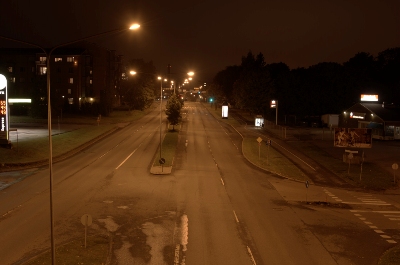Reconsidering Darkness
Matti Tainio

While a naturally dark night with starry skies is a paradigmatic example of the sublime, urban darkness has a different character. Generally speaking, true darkness hasn’t been present in most western cities since the 19th century. Contemporary urban night is not pitch-black due to illumination. Its darkness is incomplete because even the darkest corners get some light. There are just shadows and contrasts in the nooks where the streetlights do not reach. Despite the partial quality of the darkness, urban shadows are felt as unpleasant and intimidating.
However, the grounds for considering the aesthetic quality of urban darkness are weighty. In the northern parts of Europe, living with darkness and artificial illumination is unavoidable during the winter. Helsinki, for instance, is located at 60th latitude and during the darkest month the sun rises only six degrees above the horizon. The polar night is dark today, but it will be even darker in the future because of the impact of human-induced climate change. The warmer climate reduces the amount of snow in the winter, which intensifies the darkness. Furthermore, the warmer atmosphere will be more humid, which increases cloudiness, especially during winter months. In Northern Europe, the growth in cloudiness can be as much as 15%. At high latitudes, these slight changes have an effect: a small rise of temperature together with the increase in cloudiness makes the environment considerably darker.[1]
It is obvious that we have to learn how to cope with this new kind of weather and the deep darkness it brings. Just increasing the artificial illumination is not the solution. Resolving the situation rather requires a wider perspective. The solution aesthetics provides is to emphasize the value of the dark.[2] The aesthetics of darkness includes not only the paradigmatic starry nights and celestial events but all kinds of dark – the cloudy and rainy darkness as well as the imperfect urban darkness. The key to recognizing the diverse possibilities of darkness requires reconsidering the aesthetic qualities it provides and their value.
Already there are occasions when urban darkness is valued and experienced as positive. For instance, darkness is required as a backdrop to light festivals like the annual Lux Helsinki. The festival presents a diverse range of light art and thus large areas in central Helsinki are darkened to highlight the artworks. This blackout is not intimidating, because the resulting darkness is shared with other people. Special darkness of this kind can make the city a more desirable place even at night.
It is possible to find a satisfying approach towards darkness outside special events. Instead of just enduring the darkness and waiting for another season, one can try to find ways to appreciate different qualities of the darkness and explore its possibilities. Tom Baugh’s thoughts about mud,[3] as well as Mădălina Diaconu’s inquiry into the aesthetics of “normal” weather,[4] provide examples of the relevant approach. An attempt to find pleasure and positive experiences in something usually considered as unpleasant or unexciting introduces one necessary new perspective to darkness.
A more advanced approach to the aesthetic qualities of dark is to adapt the environment: develop and employ illumination, materials and surfaces in a way that they enhance the darkness. Certain ideas about how this would be possible can be found in Jun’ichiro Tanizaki’s essay “In Praise of Shadows” that contains descriptions of how traditional Japanese design and materials were adapted to low light situations. The choice of the right materials can turn shadows into pleasurable material that sculpts the space.[5]
Darkness can be seen as an opportunity for aesthetic experiences if one is open to the subtle aesthetics of imperfect darkness and is willing to enhance the shadows in a way that makes the unavoidable darkness meaningful and positive without sacrificing the functional aspect of the environment.
Matti Tainio
matti.tainio@alto.fi, matti.tainio@iki.fi
Postdoctoral researcher, Pori Urban Platform, Aalto University
Published January 3, 2019.
Cite this article: Matti Tanio, “Reconsidering Darkness,” Contemporary Aesthetics 17 (2019), accessed date.
Endnotes
[1] Jouni Räisänenand Joonas Eklund, “21st century changes in snow climate in Northern Europe as simulated by regional climate models in the ENSEMBLES project: a high-resolution view from ENSEMBLES regional climate models,” Climate Dynamics 38:11 (2012) (DOI: 10.1007/s00382-011-1076-3) 2575-2591; ref. on 2588-2590.
B. Santer, et al., “Identification of human-induced changes in atmospheric moisture content,” Proceedings of the National Academy of Sciences (USA) 104:39 (Sep 2007) 15248-15253;ref. on 15253.
Kimmo Ruosteenoja and Petri Räisänen, “Seasonal Changes in Solar Radiation and Relative Humidity in Europe in Response to Global Warming,” Journal of Climate 26:8 (2013) (DOI: 10.1175/JCLI-D-12-00007.1) 2467-2481; ref. on 2479-2480.
